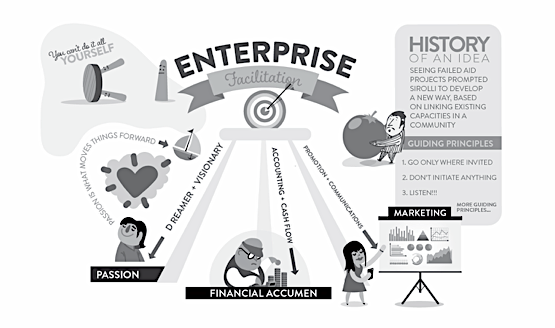Enterprise Facilitation
Episode #6 of the course 10 tools for change by Kate Sutherland
Welcome back!
Today, you’ll grow your toolkit with the simple yet game-changing Enterprise Facilitation framework. See how it applies to you personally, as well as the contexts you care about.
According to this tool, the success of an enterprise or initiative is possible even in the most unlikely circumstances if one convenes three elements:
1. an idea backed by passion, determination, and either know-how or the willingness to learn
2. solid marketing and promotion
3. financial acumen—accounting, risk assessment, cash flow, scaling up, and so on
Facilitate convergence of this “trinity of management,” and you have a strong foundation for a successful enterprise. Leave out even one of the “legs” of this three-legged stool, and the initiative is compromised—likely to wobble or fail.
Seldom, however, does one person have all three skill sets. The competencies are so different: The type of person with a passion to create tends not to have an interest in accounting and often neglects marketing. When two people get together to start a business, most pairs cover only one or two elements of the management trinity. The same holds true for community initiatives.
Whether for profit or community benefit, this way of seeing is as powerful and profound as it is simple.

Origins
Enterprise Facilitation came from Ernesto Sirolli’s reflections on the dismal failure of aid projects that he worked on in Zambia in the 1970s. There, as in countless other places, top-down approaches—too often culturally inappropriate—wasted billions. For example, Sirolli worked on a project to grow tomatoes, a food of no interest to Zambians, where farm laborers had to be bribed with beer to participate, and in the end, the entire crop was eaten or destroyed in one night by hippopotamuses.
Sirolli found most development aid similarly patronizing or paternalistic, treating recipients like employees or children, respectively. Determined to find a better way, he pioneered Enterprise Facilitation, where the guiding principles are elegantly simple.
Guiding principles:
• Go only where invited.
• Do not initiate anything.
• Listen!
• Pay attention to what people want to do—is there an idea backed by passion?
• Remove barriers to success.
Sirolli’s passion was to find a way of working such that communities would invite him in—no more imposing top-down solutions that were damaging to and disrespectful of the communities they were supposed to serve.
From Schumacher, he learned, “If you want to be invited, do something beautiful in your own community. Good news will travel fast.” And it has: Enterprise Facilitation has been dramatically successful in all parts of the world, including Africa, remote Australian communities, and some of the most economically challenged counties in the United States.
Enterprise Facilitator
The strategic element of Enterprise Facilitation is the linking function of an Enterprise Facilitator: someone passionate about helping people do beautifully what they love to do. With Sirolli’s focus on community economic development, the enterprise facilitator’s job description is to show up in town, make it known through flyers, networks, and the local media that they are available to help anyone with an idea for a small business, and wait patiently in local cafés or the town square for people to approach them.
Takeaways
Embedded in Enterprise Facilitation are recommendations for anyone with a passion to make a difference.
The first is to focus on the trinity of management. Do we have all three elements? What is missing? How can we add it? (Ditto for you personally!)
Looking more deeply, there is an emphasis on bottom-up approaches: Focus your attention and resources on people at the grassroots level who have initiative—those with specific ideas matched by enthusiasm and commitment. Enterprise Facilitation holds that they are present in every community, no matter how disadvantaged or depressed (organizations are a kind of community).
This framework says, “We have everything we need,” and that success comes from linking and connecting what is already here—bringing together the three legs. Sirolli also says that it does not have to be difficult. The water will flow naturally if we simply remove a few impediments.
Finally, cultivate the convening aspect guided by the principles of Enterprise Facilitation outlined above. All the elements may be in the system, but without connecting the dots, they languish. Find a way to embody the enterprise facilitator role, either by mandating a specific person or by supporting the networking/linking function in other ways.
I hope this tool helps you as much as it has helped me!
Tomorrow’s tool, Adaptive Cycle, names the four phases you must go through to stay healthy and resilient over the long haul. Which phase is your team/initiative/organization in? Knowing will help you navigate!
Till soon!
Kate
Recommended book
Share with friends

